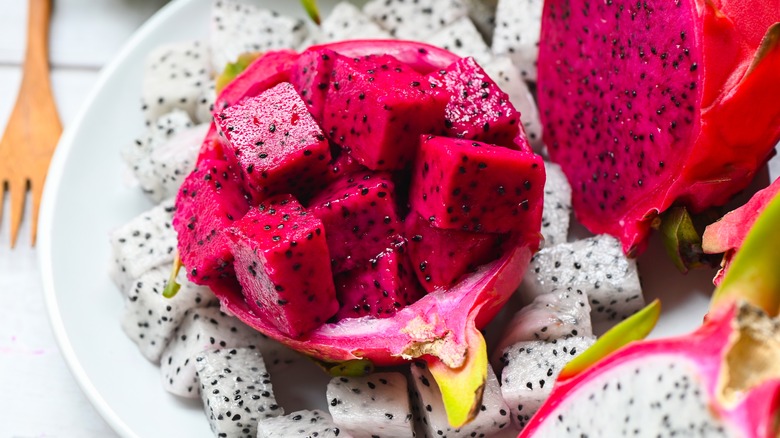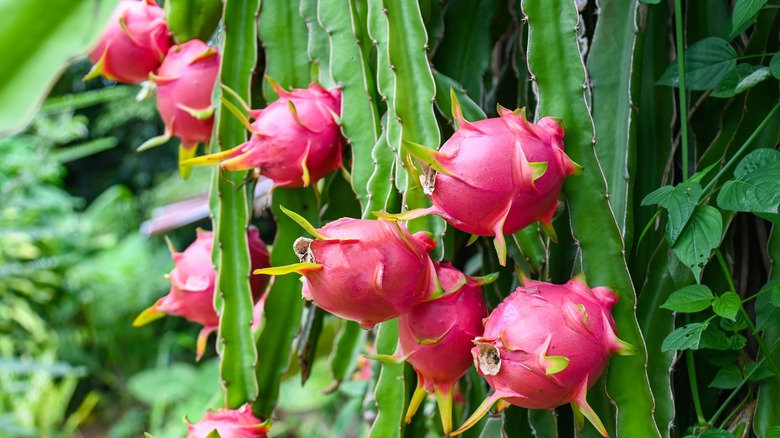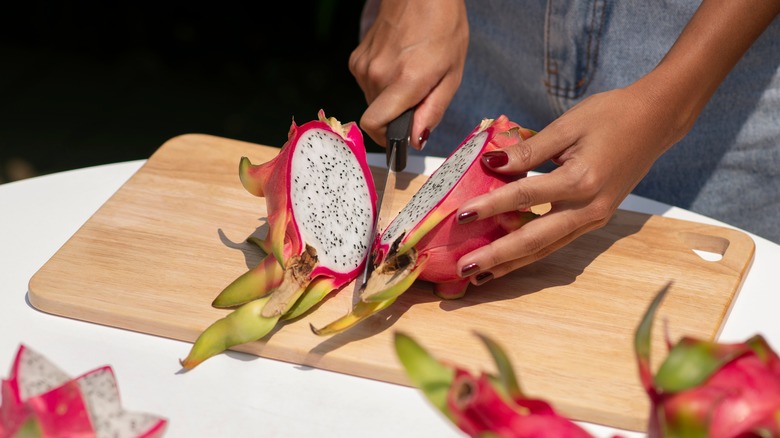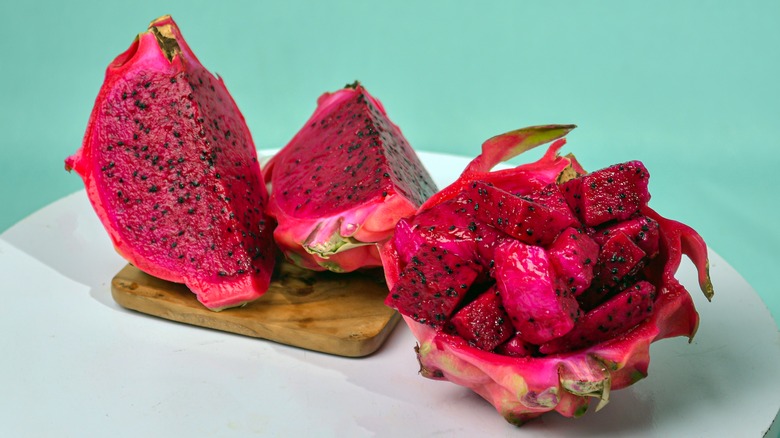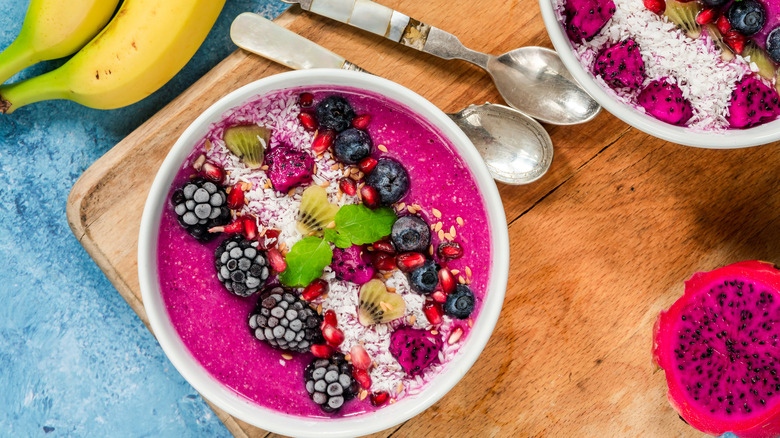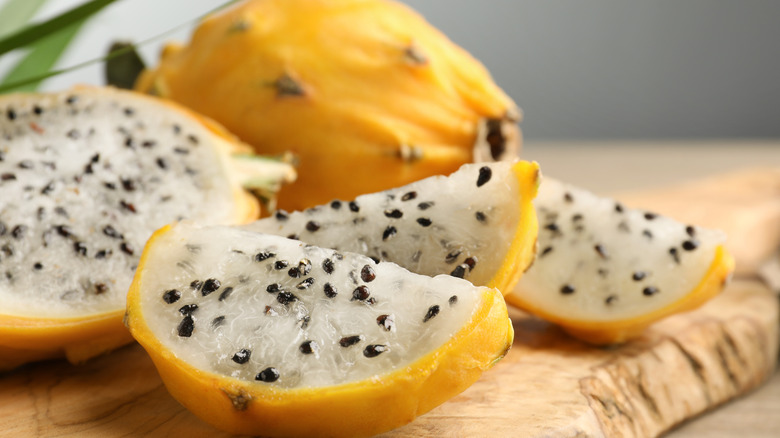How To Eat Dragon Fruit And Bring Out Its Flavors
Dragon fruit looks otherworldly — bright magenta, sunset pink, or lemon yellow with flame-like green petals. When you slice one of these orbs in half, the inside is equally stunning. The flesh has an abundance of tiny black seeds and ranges from white with a slightly grayish hue to deep fuchsia.
With such a show-stopping appearance, you would expect the taste of dragon fruits to be just as vibrant, but that's actually not the case. The taste of dragon fruit is very mild — lightly sweet, and depending on variety, sometimes slightly sour. Many compare the taste and texture to a combination of kiwi, pear, and barely ripe watermelon. Like a ripe pear, it is somewhat grainy and can be scooped with a spoon. The texture from the abundance of tiny seeds is reminiscent of kiwi, and while not as juicy as a watermelon, dragon fruit has a watery quality. The taste of dragon fruit is unique, understated, and refreshing.
What are the different types of dragon fruit?
Dragon fruit, also called pitaya, pitahaya, or strawberry pear, is native to Central and South America but is now grown in other tropical and subtropical regions in countries like India, Vietnam, Thailand, Australia, and the Philippines. There are four different species of dragon fruit. Yellow-skinned and white-fleshed dragon fruits (Selenicereus megalanthus) only have one known variety. The remaining three species have skin that ranges from light to vibrant pink with white flesh (Hylocereus undatus), red or pink flesh (Hylocereus polyrhizus), or bright purple flesh (Hylocereus guatemalensis). There are many dazzling varieties like David Bowie, which has a bubblegum pink outside and bright white inside and Zamorano, which are rounder in shape and have beet red flesh. Most dragon fruits range in size from about four to six inches, but the Voodoo Child variety is smaller and egg-shaped, reminiscent of a prickly pear fruit.
Dragon fruit grows on a type of climbing cactus, so it is part of the Cactaceae family. These cacti have dramatic white flowers that bloom for only one night at a time, inspiring the cactus to be referred to as a "moonflower" or "Lady of the Night." The plant produces fruit four to six times a year and can continue to do so for up to around 30 years.
How to cut dragon fruit
Once you get your hands on one, you may be wondering how to cut dragon fruit, and what to do with the shell. This fruit is actually super easy to prepare; if you've cut an avocado before, you can cut a dragon fruit. All you need is a sharp knife and a cutting board.
Start by slicing the dragon fruit in half lengthwise, and scoop out the flesh with a spoon. Alternatively, slice it into four wedges and carefully peel the rind from the fruit, so you can slice and dice the flesh more easily. To keep the whole fruit intact without cutting it, cut off the two ends, score a slit in the skin from top to bottom, and then wedge your fingers underneath the skin. You should be able to pull off the entire rind, leaving only the flesh.
Whatever method you choose, do not throw away that peel! If you keep it in two halves, you can use it as miniature serving bowls that add a striking visual appeal to your dragon fruit dishes (or just cubes of the flesh itself, maybe with a garnish of mint). Or, there are tons of ways to eat the skin itself in recipes from stir-fries to desserts.
How to store dragon fruit
An uncut dragon fruit will last for one to two weeks, but that time will vary, depending on how long the fruit was already sitting in the store before you bought it. Keep it on the counter if you want it to ripen a bit, or stash it in the refrigerator to slow the process down.
Once a dragon fruit is cut, it tends to go bad pretty quickly. The flesh can oxidize and turn mushy within just a couple days. If you have some leftover fruit that you plan to eat pretty soon, an airtight container is your best bet for storage. Otherwise, freezing freshly cut dragon fruit is a great way to keep it usable for months to come.
To try it, just cut the fruit into bite-sized pieces, and freeze the cubes in one layer on a parchment-lined baking sheet or plate. Once frozen, transfer the pieces to a freezer-safe resealable bag or container. The fruit will stay vibrant and flavorful for up to about six months. Use the pieces to make instant sorbets, smoothies, sauces, açaí bowls, frozen cocktails, or even yogurt parfaits!
Make dragon fruit shine
When ripe, dragon fruit smells pleasantly floral, with that characteristic honeyed tropical fruit funk, though not nearly as pungent as durian. Unripe dragon fruit has no discernable smell, but when they have gone bad, they smell rancid. While yellow and red-fleshed dragon fruits are sweeter, all dragon fruits have a pretty mild taste and can benefit from additions to give a little oomph. A drizzle of honey can make a world of difference. You don't need much, but the complex sweetness of honey dials up the subtle flavors of the dragon fruit. Using yogurt as a base for a dragon fruit-centric breakfast, snack, or dessert is another excellent way to enhance flavor. Yogurt adds creaminess, heft, and tang.
For double the flavor-boosting impact, make a smoothie bowl with frozen dragon fruit, honey, and yogurt. To really maximize the unique beauty of this tropical delight, use a white-fleshed dragon fruit for the base and top with pretty spheres of red dragon fruit, scooped with a melon baller. Compliment with brightly colored tangy fruits like pineapple, mango, or oranges. Go for a monochrome look with a red-fleshed dragon fruit base, and top with strawberries, pomegranate seeds, blood orange supremes, and chocolate-covered dried cherries.
You can also take dragon fruit in a savory direction and combine it with red onion, cucumber, cilantro, and lime juice for a salsa that would be great on shrimp tacos. Add to salads and grain bowls for sweetness and textural intrigue.
Where can you buy dragon fruit?
Large retailers like Wal-Mart, Kroger, Safeway, and Whole Foods Market sometimes carry fresh dragon fruit in the produce section. However, this is more of a specialty item, so it's worth double-checking the availability at your local location. You will probably have the best luck at a market specializing in Latin American or Asian products.
If you can't find any fresh, or the price tag is too steep, don't worry. There are other options! You can find frozen dragon fruit cubes or smoothie packs at Target and Amazon, as well as many supermarkets, or you can snag canned dragon fruit in a pinch. Freeze-dried dragon fruit powders are great for beverages or buttercreams, and Trader Joe's even has dragon fruit chips, perfect for a healthy snack or creative cocktail garnish. Pitaya Foods, which works with organic dragon fruit farms in Nicaragua, supplies various dragon fruit products to these stores, and you can also buy directly from them online.
Is dragon fruit good for you?
When fruits and vegetables are brightly colored, it indicates that they are nutrient dense. Consuming a wide array of colors helps ensure that your body is getting the nourishment it needs. Dragon fruit definitely fits the bill. It is high in fiber and magnesium, and has a good amount of vitamin C and iron. Additionally, dragon fruits are high in antioxidants — hydroxycinnamates that may help prevent cancer, flavonoids that support brain and heart health, and in red-fleshed fruits, betalains that affect LDL cholesterol and help protect against cardiovascular disease. Try making a powerhouse smoothie with dragon fruit, carrot, pineapple, kale, and blueberries to get the nutritional benefits of the entire rainbow!
Because dragon fruit is quite high in fiber, it can cause cramping, bloating, and gas, but that is really only something to consider if you are eating large quantities or have a diet that is exceptionally high in fiber. If you have never had dragon fruit before, the good news is that allergies to dragon fruit are very rare. Nothing is stopping you from getting your hands on some dragon fruit and giving it a try!

